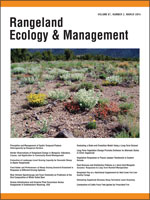The presence of sagebrush (Artemisia tridentata) in rangelands has declined due to the invasion of annual grasses such as cheatgrass (Bromus tectorum) and the feedback between these flammable grasses and wildfire frequency. Monitoring the change and distribution of suitable habitat and fuel loads is an important aspect of sagebrush management, particularly under future climate conditions. Assessments of sagebrush biomass are used to monitor habitat for critical wildlife species, determine fire risk, and quantify carbon storage. Field techniques such as destructive and point-intercept sampling have been used to determine sagebrush biomass, but both of these techniques can be expensive and time consuming to implement. Light detection and ranging techniques, including airborne laser scanning and terrestrial laser scanning (TLS) have potential for rapidly assessing biomass in sagebrush steppe. This study used TLS to estimate biomass of 29 sagebrush plants in Reynolds Creek Experimental Watershed, Idaho. Biomass was estimated using TLS-derived volume, then compared with destructive samples to assess the estimation accuracy. This accuracy level was then contrasted with the estimates obtained using point-intercept sampling of the same plants. The TLS approach (R2 = 0.90) was slightly better for predicting total biomass than point-intercept sampling (R2 = 0.85). Prediction of green biomass, or production, was more accurate using TLS-derived volume (R2 = 0.86) than point-intercept sampling (R2 = 0.65). This study explores a promising new method to repeatedly monitor sagebrush biomass across extensive landscapes. Future work should focus on making this method independent of sensor type, scan distance, scan number, and study area.
How to translate text using browser tools
1 March 2014
Estimating Sagebrush Biomass Using Terrestrial Laser Scanning
Peter J. Olsoy,
Nancy F. Glenn,
Patrick E. Clark
ACCESS THE FULL ARTICLE

Rangeland Ecology and Management
Vol. 67 • No. 2
March 2014
Vol. 67 • No. 2
March 2014
Artemisia tridentata
monitoring
sagebrush steppe
terrestrial LiDAR
voxel volume




